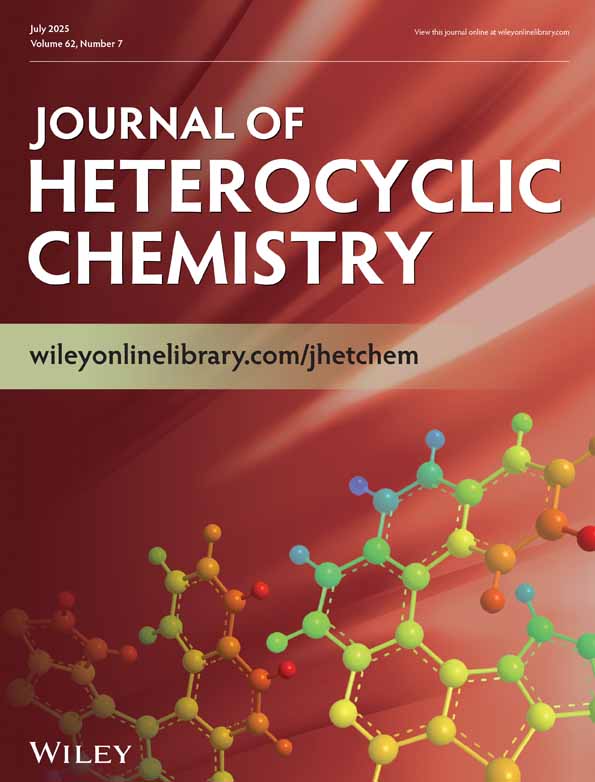The behaviour of 2-nitrothiophene and of 3-nitrothiophene with some nucleophiles
Carlo Dell'Erba
Institute of Organic Chemistry, University of Genova and Institute of Organic Chemistry, University of Palermo, via Archirafi 20, Palermo, Italy 90123
Search for more papers by this authorMarino Novi
Institute of Organic Chemistry, University of Genova and Institute of Organic Chemistry, University of Palermo, via Archirafi 20, Palermo, Italy 90123
Search for more papers by this authorGiuseppe Guanti
Institute of Organic Chemistry, University of Genova and Institute of Organic Chemistry, University of Palermo, via Archirafi 20, Palermo, Italy 90123
Search for more papers by this authorDomenico Spinelli
Institute of Organic Chemistry, University of Genova and Institute of Organic Chemistry, University of Palermo, via Archirafi 20, Palermo, Italy 90123
Search for more papers by this authorCarlo Dell'Erba
Institute of Organic Chemistry, University of Genova and Institute of Organic Chemistry, University of Palermo, via Archirafi 20, Palermo, Italy 90123
Search for more papers by this authorMarino Novi
Institute of Organic Chemistry, University of Genova and Institute of Organic Chemistry, University of Palermo, via Archirafi 20, Palermo, Italy 90123
Search for more papers by this authorGiuseppe Guanti
Institute of Organic Chemistry, University of Genova and Institute of Organic Chemistry, University of Palermo, via Archirafi 20, Palermo, Italy 90123
Search for more papers by this authorDomenico Spinelli
Institute of Organic Chemistry, University of Genova and Institute of Organic Chemistry, University of Palermo, via Archirafi 20, Palermo, Italy 90123
Search for more papers by this authorAbstract
The reactivity of 2-nitrothiophene (1) and of 3-nitrothiophene (II) with some nucleophiles has been studied. According to calculated electronic densities I can receive nucleophilic attack at C3 and C5 depending on the nucleophile used, but II only at C2. With N-lithium piperidine both I and II also give coupling products (VII and XI respectively) of the hithienyl type.
References
- 1 E. Buncel, A. R. Norris and K. E. Russell, Quart. Rev., 22, 123 (1968). P. Buck, Angew. Chem. Intern. Edit. Engl., 8, 120 (1969). M. R. Crampton, “ Advances in Physical Organic Chemistry”, Academic Press, N. Y., 7, 211 (1969). M. J. Strauss, Chem. Rev., 70, 667 (1970). M. R. Crampton, J. Chem. Soc. (B). 2112 (1971). M. Makosza and M. Jawdosink, Chem. Commun., 648 (1970). V. Kalyanaraman and M. V. George, J. Org. Chem., 38, 507 (1973).
- 2
W. Steinkopf,
Ann. Chem.,
513,
285
(1934).
10.1002/jlac.19345130119 Google Scholar
- 3a D. Spinelli, V. Armanino and A. Carrao, J. Heterocyclic Chem., 7, 1441 (1970). b G. Doddi, G. Illuminati and F. Stegel, Chem. Commun., 953 (1969). J. Org. Chem., 36, 1918 (1971). P. Bemporad, G. Illuminati and F. Stegel, J. Am. Chem. Soc., 91, 6742 (1969). c G. Doddi, G. Illuminati and F. Stegel, Chem. Commun., 1143 (1972). C. Paulmier, M. P. Simonini, A. P. Chatrousse and F. Terrier, Tetrahedron Letters, 1123 (1973).
- 4a C. Dell'Erba, D. Spinelli and G. Leandri, Chem. Commun., 549 (1969). b G. Guanti, C. Dell'Erba and G. Leandri, Chem. Commun., 1060 (1972).
- 5 R. A. Hoffmann and S. Gronowitz, Arkiv Kemi, 16, 515 (1960).
- 6 M. J. Bulman, Tetrahedron, 25, 1433 (1969).
- 7 H. Maag and B. K. Manukian, Helv. Chem. Acta, 56, 1787 (1973).
- 8 M. R. Crampton and V. Gold, J. Chem. Soc., 4293 (1964).
- 9a W. Bradley and R. Robinson, J. Chem. Soc., 1254 (1932). b F. W. Bergstrom, I. M. Granara and V. Erickson, J. Org. Chem., 7, 98 (1942). c R. Huisgen and H. Rist, Ann. Chem., 594, 159 (1955).
- 10 L. Melander, Acta Chem. Scand., 9, 1400 (1955). Arkiv Kemi, 11, 397 (1957).
- 11 In the cases studied the solvent change between two poorly solvating solvents (ethyl ether or toluene) does not seem to affect isomeric distribution of reaction products. Absence of products deriving from attack at C5 can depend on formation of ring cleavage products (4b), which undergo decomposition in the experimental conditions used.
- 12 Different behaviour as a function of the metal present can be related to the different radius or complexing power of the cation and to different polar structures (intimate ion-pair, ion-pair, and so on) of the various metalamines. These factors affect the results obtained as a function of solvent [see P. Haberfield and R. B. Trattner, Chem. Commun., 1481 (1971) and references therein].
- 13 G. A. Russell, E. G. Janzen and E. T. Strong, J. Am. Chem. Soc., 86, 1807 (1964). see also N. L. Holy and J. D. Marcum, Angew. Chem. Intern. Edit. Engl., 10, 115 (1971) and references therein.
- 14 Considering the fact that radical anions have been proposed as the first products of reaction in some nucleophilic substitutions [see e.g. J. F. Bunnett and J. K. Kim, J. Am. Chem. Soc., 92, 7463 (1970)], in an alternative reaction pattern XIV could be the precursor also of XIII.
- 15 V. S. Babasinian, Org. Syn., Coll. Vol. II, 357, N. Y. 1943,
- 16 A. H. Blatt, S. Bach and L. W. Kresch, J. Org. Chem., 22, 1693 (1957).
- 17 C. Dell'Erba and G. Guanti, Gazz. Chim. Ital., 100, 223 (1970).
- 18 C. Dell'Erba, G. Garbarino and G. Guanti, Gazz. Chim. Ital., 100, 916 (1970).
- 19 D. Spinelli, C. Dell'Erba and A. Salvemini, Ann. Chim. (Rome), 52, 1156 (1962).
- 20 C. Carpanelli and G. Leandri, Ann. Chim. (Rome), 51, 181 (1961).
- 21 R. G. R. Bacon and D. J. Maitland, J. Chem. Soc., 1973 (1970).




